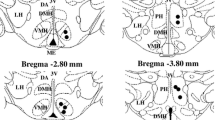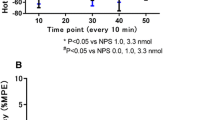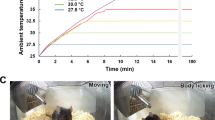Abstract
Exposure (2 h) of adult male albino rats to higher environmental temperature (HET, 40°C) significantly increased body temperature (BT). Administration of (a) 5-HTP (5 mg/kg, i.p.) or morphine (1 mg/kg, i.p.) or physostigmine (0.2 mg/kg, i.p.) alone significantly increased and (b) methysergide (1 mg/kg, i.p.) or naloxone (1 mg/kg, i.p.) or atropine (5 mg/kg, i.p.) reduced the BT of both normal and HET exposed rats. Further, it was observed that morphine prevented the methysergide-induced hypothermia and 5-HTP potentiated the morphine-induced hyperthermia in both normal and HET exposed conditions. Biochemical study also indicates that serotonin metabolism was increased but GABA utilization was reduced following exposure to HET. 5-HTP or bicuculline-induced hyperthermia in control and HET exposed rat was potentiated with the coadministration of bicuculline and 5-HTP. The cotreatment of bicuculline with methysergide prevented the methysergide-induced attenuation of BT of heat exposed rat, rather BT was significantly enhanced indicating that inhibition of GABA system under heat exposed condition may activate the serotonergic activity. Further (a) enhancement of (i) morphine-induced hyperthermia with physostigmine (ii) physostigmine- or morphine + physostigmine-induced increase of BT with 5-HTP and (b) reduction of (i) morphine- or morphine + 5-HTP-induced hyperthermia with atropine and (ii) atropine-induced hypothermia with 5-HTP in both normal and HET exposed conditions suggest that HET exposure activates the cholinergic system through the activation of opioidergic and serotonergic system and hence increased the BT. Thus, it may be concluded that there is an involvement of serotonergic regulation in the opioidergic-cholinergic interaction via GABA system in HET-induced increase in BT.
Similar content being viewed by others
References
Siesjo, B. K. 1978. Hypothermia and Hyperthermia. Pages 324–344,in B. K. Siesjo (ed). Brain Energy Metabolism, Wiley, New York.
Berry, J., Montgomery, L. D., and Williams, B. A. 1984. Thermoregulatory responses of rats to varying environmental temperatures. Avia. Space. Environ. Med. 55:546–549.
Bligh, J. 1981. Amino acids as central synaptic transmitters or modulators in mammalian thermoregulation. Fed. Proc. 40:2746–2749.
Lipton, J. M., and Clark, W. G. 1986. Neurotransmitter in temperature control. Ann. Rev. Physiol. 48:613–623.
Bligh, J., Cottle, W. H. and Maskrey, M. 1971. Influence of ambient temperature on the thermoregulatory response of 5-hydroxytryptamine, noradrenaline and acetylcholine injected into the lateral cerebral ventricles of sheep, goats and rabbits. J. Physiol. 212:377–392.
Matthew, C. B., Hubbard, R. W., and Francesconi, R. P. 1989. Atropine, diazepam and physostigmine: thermoregulatory effects in heat stressed rat. Life Sci. 44:1921.
Cox, B., Kervin, E., and Lee, T. F., 1978. Dopamine receptors in the central thermoregulatory pathway of rat. J. Physiol. 282:471–483.
Minano, F. J., Sancibrian, M., and Serrano, J. S. 1987. Hypothermic effect of GABA in conscious stressed rats: Its modification by cholinergic agonists and antagonists. J. Pharm. Pharmacol. 39:721–726.
Biswas, S., and Poddar, M. K. 1990. Does GABA act through dopaminergic cholinergic interaction in the regulation of higher environmental temperature-induced change in body temperature. Meth. Find. Exp. Clin. Pharmacol. 12:303–307.
Pan, Z. Z., Colmers, W. F., and Williams, J. T. 1989. 5HT-mediated synaptic potentials in the dorsal raphenucleus: Interaction with excitatory amino acids and GABA neurotransmission. J. Neurophysiol. 62:481–486.
Milner, T. A., and Bacon, C. E. 1989. GABAergic neurons in the rat hippocampal formation: Ultrastructure and synaptic relationship with catecholaminergic terminals. J. Neurosci. 9:3410–3427.
Robins, H. I., Kalin, N. H., and Shelton, S. E. 1987. Neuroendocrine changes in patients undergoing whole body hyperthermia. Int. J. Hyperthermia 3:99–106.
Nicoll, R. A., Alger, B. E., and Johr, C. E., 1980. Enkephalin blocks inhibitory pathways in the vertebrate CNS. Nature 287:22–25.
Scatton, B., Zivkovic, B., Dedek, J., Lloyd, K. G., and Barthotini, G. 1981. γ-Aminobutyric acid receptor stimulation. Effect of progabide on norepinephrine, dopamine and 5-hydroxytryptamine turnover in rat brain areas. J. Pharmacol. Exp. Therap. 220:678–688.
Gallager, D. W., and Aghajanian, G. K. 1976. Effect of antipsychotic drugs on the firing of dorsal raphe cells. Reversed by picrotoxin. Eur. J. Pharmacol. 39:357–364.
Romandini, S., and Samanin, R. 1984. Muscimol injections in the nucleus raphe dorsalis block the antinociceptive effect of morphine in rats. Brit. J. Pharmacol. 81:25–29.
Mukhopadhyay, S. and Poddar, M. K. 1988. Environmental temperature-induced change in brain regional serotonergic activity. Biogenic Amines. 5:505–515.
Corrodi, H., Fuxe, K., and Hokfelt, T., 1967. Effect of temperature in central monoamine. Acta. Physiol. Scand. 71:224–232.
Komiskey, H. L. and Rudy, T. A. 1977. Serotonergic influences on brain stem thermoregulatory mechanisms in the cat. Brain Res. 134:297–315.
Poddar, M. K. and Dewey, W. L. 1980. Effects of cannabinoids on catecholamine uptake and release in hypothalamus and striatal synaptosomes. J. Pharm. Exp. Therap. 214:63–67.
Synder, S. H., Axelrod, J. and Zweigh, M. 1965. A sensitive and specific fluorescence assay for tissue serotonin. Biochem. Pharmacol. 14:831–835.
Haubrich, D. R. and Denzer, J. S. 1973. Simultaneous extraction and fluorometric measurement of brain serotonin, catecholamine, 5-hydroxyindoleacetic acid and homovanillic acid. Anal Biochem. 55:306–312.
Lowe, I. P., Robins, E. and Eyerman, G. S. 1958. The fluorimetric measurement of glutamic decarboxylase and its distribution in brain. J. Neurochem. 3:8–18.
MacDonnell, P. and Greengard, O. 1975. The distribution of glutamate decarboxylase in rat tissue: Isotopic vs. fluorometric assay. J. Neurochem. 24:615–618.
Sytinsky, I. A., Guzikov, B. M., Eremin, V. P., and Konovalona, N. N. 1975. The gamma aminobutyric acid system in brain during acute and chronic ethanol intoxication. J. Neurochem. 25:43–48.
Leach, M. J., and Walker, J. M. G. 1977. Effect of ethanolamine-O-sulfate on regional GABA metabolism in mouse brain. Biochem. Pharmacol. 26:1569–1572.
Lowry, O. H., Rosenbrough, N. H., Farr, A. L., and Randall, R. J. 1951. Protein measurement with Folin phenol reagent. J. Biol. Chem. 193:265–275.
Mukhopadhyay, S., Roy, S. K. and Poddar, M. K. 1984. Environmental temperature-induced changes in synaptosomal membrane bound enzyme and locomotor activity. IRCS. Med. Sci. 12:283–284.
McGeer, P. L., Eccles, J. C. and McGeer, E. G. 1978. Inhibitory amino acid neurons. Pages 199–231.in, McGeer P. L. et al. (eds.) Molecular neurobiology of the mammalian brain, Plenum Press, New York.
Ghosh, S. and Poddar, M. K. 1992. Higher environmental temperature-induced increase of body temperature: Involvement of central opiodergic-GABAergic interaction. Pharmacol. Biochem. Behav. (communicated).
Majewska, M. D. 1987. Steroid and brain activity. Biochem. Pharmacol. 36:3781–3788.
Appelbaum, B. D., and Holtzman, S. G. 1984. Characterization of stress-induced potentiation of opioid effects. J. Pharmacol. Exp. Ther. 231:555–565.
Author information
Authors and Affiliations
Rights and permissions
About this article
Cite this article
Ghosh(née Biswas), S., Poddar, M.K. Higher environmental temperature-induced increase in body temperature: Involvement of serotonin in GABA mediated interaction of opioidergic system. Neurochem Res 18, 1287–1292 (1993). https://doi.org/10.1007/BF00975049
Accepted:
Issue Date:
DOI: https://doi.org/10.1007/BF00975049




